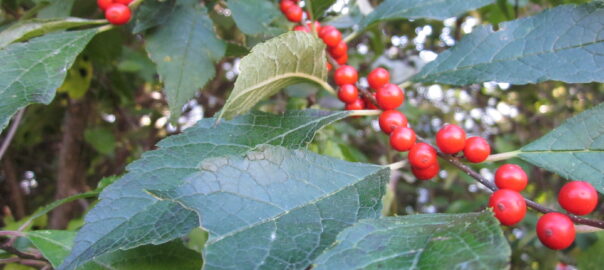
Although we haven’t yet had a killing frost, lower temperatures and shorter days are affecting our gardens and neighborhood for sure.
The leaves on nearby oak trees are turning a bright orange and their acorns are all over the street and driveways. Our Dogwood trees (Cornus Kousa) are also turning, and their beautiful bright-red berries are a delight.
There’s still a lot of color to be found from the summer leaves of shrubs such as the Ninebark (Physocarpus ‘Summer Wine’) and the Smoke tree (Cotinus coggyria ‘Royal Purple’), to name just two.
The Winterberry Holly (Ilex verticillata) will drop all its leaves by late autumn. Its lack of winter leaves will make its red-berry display all the brighter. To insure a good berry “crop,” we planted one male plant in close proximity to our three female ones. In the spring, all produce inconspicuous tiny white flowers, but only the male produces the pollen necessary for berries to develop on the female shrubs.
Our Blue Hollies (Ilex × meserveae), commonly known as Meserve Hollies, are also exhibiting beautiful red berries among the stems of shiny, blue-green evergreen leaves with pointy edges.
Still blooming are the Asters ‘Alma Potschke’, the Sedums ‘Autumn Joy’ and the Knock Out Roses. Some Chrysanthemums are just beginning to open. Interestingly, although most of the leaves of the different Hosta plants have turned brown and died off, the ‘Diana Remembered’ Hostas have recently gifted us with some lovely white blossoms.
Really amazing are the weedy annual Morning Glories (Ipomoea ‘Grandpa Ott’), which I planted years ago. They have self-seeded and return every year. I keep trying to weed them all out, but they persevere, gifting me with colorful purple blossoms.
Our Sedums have wide flat flowerheads that age from pink to burgundy to a pretty copper color. However, they tend to be top-heavy, and many have fallen over. Had I pruned them while they were elongating during the summer, it would have helped make the stems stronger. Let’s hope I remember to do so next year.
Now that it’s late in the season, I’m not trimming off any rose hips. Rose hips are the round part of a rose flower, just below the petals, where the seeds develop. They will turn a beautiful red color and ultimately provide food for our visiting birds.
Coneflowers have dropped their petals, but the seed-laden central cones are still standing, much to the delight of the finches; so they won’t be trimmed yet. Someone said that Clematis seedheads look like “cheerleader pom-poms,” so they also won’t be pruned either.
As autumn advances, I hope to savor the season before winter arrives!

